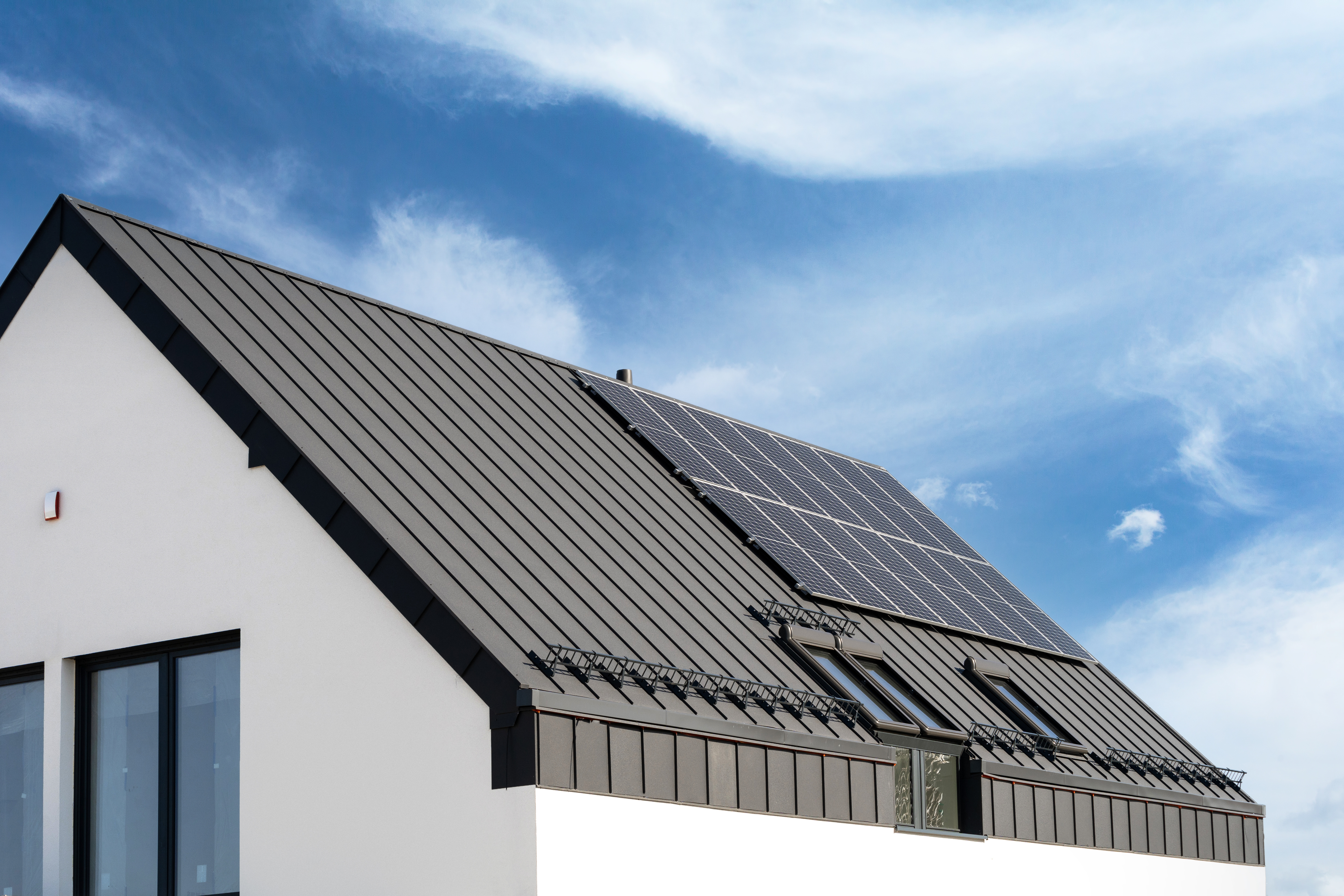
A metal roof can defend your home against Ohio’s varying weather conditions. Learn how much a metal roof costs in Columbus, OH.
An attic fan will make you a fan of your attic


Learning how to install an attic fan can be great for your entire home and your wallet. Attic fans can reduce your monthly air conditioning bills during the summer and minimize water condensation and ice damage during the winter. However, there are several considerations to explore when choosing an attic fan and deciding if it’s a DIY project you should take on.
An attic fan is more than just a vent in your roof, as it provides some much-needed ventilation for these typically stuffy rooms. Passive vents such as roof, gable, or ridge vents allow hot air to escape the space while cooler exterior air replaces it, creating vital air circulation. Attic fans mount directly through your roof deck or the gable ends of a home and actively increase circulation, resulting in better air movement.
Power attic fans are available in two main types: roof-mount units and gable-mount units. Styles include solar-power attic fans that require no electricity from the home, electric fans that operate on the home’s AC power, and dual-power units that combine the best of both types.
You may be wondering how much ventilation your attic needs. For the best ventilation, plan for at least 1 square foot of ventilation for every 300 square feet of attic space.
There are many great benefits to adding an attic fan to your home. The increased ventilation will decrease moisture buildup, which means you’re lowering the chances of mildew and mold growth. You’re also decreasing condensation levels, which helps your roofing materials last longer.
Like your kitchen or bathroom, your roof needs ventilation to extend its life span and control temperatures. Proper roof ventilation helps reduce HVAC costs and prevents ice dams and moisture damage. A roof repair pro can assess your roof and make recommendations.
Also, since your attic space will stay cooler during the hot months, your AC won’t have to work as hard to cool your home. This can translate to lower electric bills in the summer. And if you have a second story in your home, you’ll notice it’s generally cooler than before you installed the attic fan.
Depending on the type and style of fan that will work best in your home, professional attic fan installation costs between $200 and $1,500, including labor and materials. As a DIY project, expect to pay $100 to $600 for the fan, thermostat, if necessary, and installation materials.
Consider attic fan installation as an investment in your home. Getting the most benefits out of your investment requires a successful installation, which requires some careful prep work. To ensure a smooth DIY project, clear any clutter out of the attic where you’ll be working.
Keep in mind that this and any electrical project can be very dangerous, and you should only attempt it if you have experience with electrical work. If you’re uncomfortable working with electrical circuits, plan ahead and hire a local electrician to run new wires to the space before beginning the job.

Attic fan installation involves cutting holes in either the roof or the exterior wall of your home, which can cause problems later if they’re not sealed correctly after the job. Follow these installation guidelines for the style of fan you choose.
A roof-mount attic fan is an attic fan that mounts on your roof over a large hole. Its power can come from solar energy or your home’s AC service.
Choose a location for your fan. Center it midway from each end of the house and as high on the roof as possible without interfering with the ridge.
On the roof, measure the distance from the proposed location to the ridge and the exterior wall, excluding any overhanging roof sections. To access the roof, extend a ladder several feet above the eave and use extreme caution when transitioning from ladder to roof and back. You’ll want to follow a few other safety precautions here: Stay safely away from the roof edge while measuring and always avoid going onto a wet roof. Work with a buddy who can hold your ladder steady and never attempt to go up more than one story. If you don’t have experience or don’t feel comfortable going up to the roof, consider hiring a pro.
In the attic, use the measurements to find the same location on the underside of the roof deck.
Pinpoint and mark the center of the location between two rafters with a pencil or piece of tape.
At your mark inside the attic, use a narrow bit to drill a pilot hole up through the roof.
On the rooftop, use the fan or the template that came with it to trace a circle on the shingles with the pilot hole in the center.
Use a jigsaw or reciprocating saw to cut the hole through the shingles and roof deck.
Use a pry bar to lift and loosen the edges of the shingles near the hole.
Place the fan in the hole while tucking its flanges under the shingles on the top and side edges. The bottom edge will remain exposed.
Use roofing nails through the bottom flange edge to secure the fan.
Apply roofing adhesive to the nearby shingles to reattach them to the roof.
Some attic fans have built-in thermostats, while others have external thermostats. If your fan doesn’t have one built-in, follow these steps.
Find the best place for the thermostat. Avoid placing it in the path of the fan draft while staying close to the wiring.
Install the thermostat onto a stud or rafter with screws.
Gable-mount attic fan installation is made easier by using your home's existing passive gable vent. If your home doesn’t have gable vents, choose a roof-mount fan or consult a nearby siding company for assistance with creating a new hole in the exterior wall.
Measure and cut a piece of 1/2 to 3/4-inch thick plywood that’s large enough to contain your attic fan and reaches from one gable-wall stud to the next at the location of the existing vent.
Center and trace the fan body or template onto the plywood.
Use a jigsaw to cut out the shape of the fan body.
Use the fan’s mounting hardware to mount it to the plywood in the hole.
Center the fan mounting assembly over the gable vent.
Use exterior-grade screws or nails to fasten the plywood edges to the wall studs.
Install the thermostat on a nearby stud by screwing it into place. A good spot is on the bottom left- or right-side of the fan.
If necessary, your new attic fan will come with wiring instructions for the thermostat and the power supply. Follow all electrical safety precautions when working with electrical circuits to avoid injury from electrical shock, including working in a dry area and using rubber gloves. Contact an electrician to perform these tasks if you’re not comfortable working around electricity.
Turn off the electrical circuit to the attic and test to ensure it’s off with a non-contact electrical tester or probe tester. Ensure the tester works correctly by checking it on a known live circuit before use.
Plug the thermostat cable into the receptacle on the fan and mount the thermostat a few feet away on a rafter or stud.
Wire your home’s AC electrical into the fan or the regulator and switch. Install a wire clamp connector in the connection box knock out and insert the home electrical cable. Connect the white wires to white, black to black, and ground to ground using wire nuts or approved connectors. Secure the electrical box cover.
Set the thermostat temperature control and turn on your new attic fan.

Correctly installing an attic fan is crucial for proper function and prevention of water leaks. Here are some considerations and tips to help ensure installation success.
If your roof has passive box vents, choose one to remove and enlarge its hole for your attic fan to keep from having to make a completely new hole.
Consider adding several smaller attic fans instead of one large one to maximize airflow for large attics or ones with complex layouts.
Solar-powered attic fans are excellent for saving power, but not at night. In hot climates, consider dual power vents that can run on solar or A/C power for the best energy-saving benefits.
Installing roof-mount attic fans on low-slope roofs requires extra care to remain leak-free. Consider hiring a roofing company near you rather than going with a DIY installation.
While you’re in the attic for the fan installation is an excellent time to assess your insulation and decide if it’s adequate.
Choose a dry, cool weather day for installing your attic fan.
Follow all roof and ladder safety protocols during the project.
With patience and a little DIY knowledge, you can install an attic fan within a few hours for a few hundred dollars. However, be sure you’re comfortable working on a roof or ladder and with electrical circuits before starting. If you’re uncomfortable with any of those, or you’d rather find a more enjoyable way to spend your Saturday, hiring a local attic fan installer may be your best bet and is likely worth the cost.
Deane Biermeier contributed to this piece.
From average costs to expert advice, get all the answers you need to get your job done.

A metal roof can defend your home against Ohio’s varying weather conditions. Learn how much a metal roof costs in Columbus, OH.

Learn about roof replacement costs in Columbus and what factors are at play to budget accurately and make sure you’re getting a fair price.

Dealing with a visibly damaged roof or leak? Learn about roof repair costs in Columbus to see how much you’ll need to budget for a permanent solution.

Roof sealant helps protect your roof from the elements. Learn about different types of roof sealant and how to pick the right one for your roof.

A leaky roof is less than ideal. Learn how to patch a roof while you wait for repairs from the pros to prevent further damage to your home.

What's a cupola? Is it possible to have one on my home? What do they look like? Learn all about the variety of cupolas you can add to your home or barn.